Abstract
This paper aims to resolve the issue of the ranking of the fuzzy numbers in decision analysis, artificial intelligence, and optimization. In the literature, many ideas have been established for the ranking of the fuzzy numbers, and those ideas have some restrictions and limitations. We propose a method based on spherical fuzzy numbers (SFNs) for ranking to overcome the existing restrictions. Further, we investigate the basic properties of SFNs, compare the idea of spherical fuzzy set with the picture fuzzy set, and establish some distance operators, namely spherical fuzzy distance-weighted averaging (SFDWA), spherical fuzzy distance order-weighted averaging (SFDOWA), and spherical fuzzy distance order-weighted average weighted averaging (SFDOWA WA) operators with the attribute weights’ information incompletely described. Further, we design an algorithm to solve decision analysis problems. Finally, to validate the usage and applicability of the established procedure, we assume the child development influence environmental factors problem as a practical application.
1. Introduction
In the actual decision-making environment, it is of great importance to derive exact assessment information. However, due to the indeterminacy of the practical environment, we can not always achieve this goal. Then, to overcome this limitation, the concept of the fuzzy set (FS) [1] was defined. The FS is mainly characterized by the degree of membership and can provide more reasonable decision-making information. After their prosperous and successful applications, Atanassov [2] generalized this concept and improved the notion of FS as the intuitionistic fuzzy set (IFS), in which each element can be written in the form of an ordered pair. Under this situation, many scholars have paid more attention to IFSs to aggregate the different options using different methods and operators. Yager [3] proposed the order-weighted averaging (OWA) operator to aggregate the IFNs. In [4], Xu and Yager explored the idea of geometric and order geometric operators of IFNs and also developed their application for selecting the best options in daily life problems. In [5], Xu explored the idea of the weighed averaging operator based on IFNs. In [6,7], Wang and Liu explored the notion of many operators such as the intuitionistic fuzzy Einstein weighted geometric operator, order weighted geometric operator, weighted averaging operator, and order weighted averaging operator based on the Einstein operations and applied these operators to decision-making problems.
After many applications of IFSs, Yager observed that there are many shortcomings in this theory and introduced the notion of the Pythagorean fuzzy set (PyFS) [8] to generalize the concept of the Atanassov IFS. Many researchers contributed to PyFS by proposing different techniques for decision-making problems to deal with uncertainties. Khan et al. [9] proposed the Pythagorean fuzzy Dombi aggregation operators and discussed their applications. Zhang and Xu [10] proposed the TOPSIS method for PyFS information to deal with uncertainty in the form of the Pythagorean fuzzy set. Yager and Abbasov [11] established Pythagorean fuzzy aggregation operators and proposed their application in multi-attribute decision-making problems. For more study of decision-making techniques, we refer to [12,13,14].
The picture fuzzy set (PFS), as an extension of the intuitionistic fuzzy set, was firstly proposed by Cuong [15]. After that, in order to solve multi-criteria group decision-making (MCGDM) problems, it was proposed to use the picture fuzzy information. With regard to measurement, Singh et al. developed the approach with picture fuzzy correlation coefficients [16], Wei et al. [17] introduced a novel method to solve MCGDM voting problems using cross-entropy of the picture fuzzy set. As for the aggregation operators, Wei et al. [18] used the picture two-tuple linguistic-based operators, including the Bonferroni mean operator, the weighted averaging operator, and the ordered weighted averaging operator. In [19], a series of aggregation operators was proposed to aggregate the picture fuzzy information and to solve the MCGDM issues well. Ashraf et al. [20] developed the picture linguistic fuzzy set and discussed its application in decision-making problems. For more study of the decision-making techniques using picture fuzzy information, we refer to [21,22,23,24,25].
Cuong’s PFS possessed the same problem as IFS had, i.e., it bounds the sum of positive membership, neutral membership, and negative membership grades between zero and one. This restriction does not allow decision makers to select the values of the three characteristic functions. Realizing this issue, Ashraf and Abdullah [26] developed a new model of the spherical fuzzy set (SFS). It basically bounds the square sum of positive, neutral, and negative membership grades between zero and one. Ashraf et al. [27] developed the aggregation operators to aggregate the uncertainty in the form of spherical fuzzy information and proposed the GRAmethod [28] to deal the decision-making problems. Ashraf et al. [29] developed the spherical fuzzy measure on the basis of the cosine and tangent function and a proposed related application in decision making. Rafiq et al. [30] proposed the spherical fuzz set representation on the basis of the t-norm and the t-conorm. Zeng et al. [31] proposed the spherical fuzzy rough set model and discussed its application using the TOPSIS approach. Ashraf et al. [32] introduced the spherical fuzzy Dombi aggregation operators and their applications. Jin et al. [33] proposed the spherical fuzzy logarithmic aggregation operators based on entropy and gave some applications related to decision support systems. In [34], Jin et al. proposed the linguistic spherical fuzzy set and discussed its applications in decision making.
From the previous studies, we see that the use of spherical fuzzy set is growing well and that it is effective in decision-making problems. In this paper, we propose the spherical distance measure on the basis of distance operators. The main contributions of this paper are as follows:
Firstly, based on the concept of the spherical fuzzy set, a spherical fuzzy measure is defined.
Secondly, utilizing the concept of the proposed spherical distance measure, the spherical fuzzy distance aggregation operators are introduced to deal the uncertainty and inaccurate information in decision making problems in the form of a spherical fuzzy set.
Thirdly, we propose an algorithm using spherical distance measures to deal with decision-making problems.
Fourthly, to show the effectiveness and reliability of the proposed technique, a real-life problem of the child development influence environmental factors is demonstrated.
The rest of this study is organized as follows. Section 2 briefly introduces the basic knowledge about the extension of fuzzy sets. In Section 3, the distance measure of SFSs is proposed. Four phases, like calculating the overall criteria weights and establishing difference techniques, are included. In Section 4, the detailed evaluation procedures of the proposed method are exemplified by a case study after the evaluation criteria system is built. Section 5 gives some discussions on the application of the proposed method, and essential conclusions are drawn in Section 6. The paper structure is shown in Figure 1.
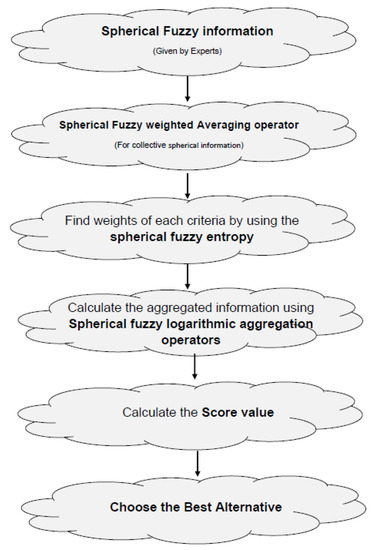
Figure 1.
Paper structure.
2. Preliminaries
We assume that the reader is familiar with the classical results of fuzzy algebras, but to make this work more self-contained, we introduce the basic notations used in the text and briefly mention some of the concepts and results employed in the rest of the work.
Definition 1
([35]). A mapping with weighted vectors such that:
where is the largest distance of with The OWA operator satisfies the commutation, monotonicity, boundedness, and idempotency properties.
Definition 2
([35]). An order-weighted averaging distance mapping with weighted vectors such that:
where is the largest distance of with The OWAD operator satisfies the commutation, monotonicity, boundedness, and idempotency properties.
Definition 3
([35]). An order weighted distance measure mapping with weighted vectors such that:
where is the distance of with and is any permutation of , such that
Definition 4
([1]). A fuzzy set (FS) on the universe of discourse is defined as:
An FS in a set is indicated by The function indicates the positive membership degree of each
Definition 5
([2]). An intuitionistic fuzzy set (IFS) on the universe of discourse is defined as:
An IFS in a set is indicated by and The functions and indicate the positive and the negative membership degrees of each respectively. Furthermore, and satisfy for all
Definition 6
([3]). A Pythagorean fuzzy set (PyFS) on the universe of discourse is defined as:
A PyFS in a set is indicated by and are the positive and negative membership degrees of each , respectively. Furthermore, and satisfy for all
Definition 7
([15]). A PFS on the universe of discourse is defined as:
A PFS in a set is indicated by , , and are the positive, neutral, and negative membership degrees of each , respectively. Furthermore, , and satisfy for all
Cuong in 2014 [15] introduced the distance of two picture fuzzy numbers (PFNs), which are discussed here:
Definition 8
([15]). For a set F and any two PFNs in F. The normalized Hamming distance is given as, for all ,
Definition 9
([15]). For a set F and any two PFNs in F. The normalized Euclidean distance is given as, for all ,
Definition 10
([26]). A SFS on the universe of discourse is defined as:
An SFS in a set is indicated by , , and are the positive, neutral, and negative membership degrees of each , respectively. Furthermore, , and satisfy for all
is said to be the refusal degree of r in , for SFS , for which triple components are said to be SFN, and each SFN can be denoted by , where and , with the condition that
Definition 11.
Let and be two SFNs defined on the universe of discourse ; some operations on SFNs are defined as follows:
- (1)
- (2)
- :
- (2)
- Union:
- (4)
- Intersection:
- (5)
- Compliment:
Proposition 1.
Assume that , and are any three SFNs on the universe of discourse . Then, the following properties are satisfied:
- (1)
- Associativity:
- (2)
- Commutativity:
- (3)
- Distributivity:
- (4)
- De Morgan laws:
Definition 12.
Let and be two SFNs defined on the universe of discourse ; some operations on SFNs are defined as follows with
- (1)
- (2)
Definition 13.
Let be any SFNs. Then:
- (1)
- , which is denoted as the score function.
- (2)
- , which is denoted as the accuracy function.
- (3)
- , which is denoted as the certainty function.
The idea taken from Definition 13 is the technique used for equating the SFNs and can be described as:
Definition 14.
Assume that and are any two SFNs on the universe of discourse . Then, by using the Definition 13, the equating technique can be described as,
- (1)
- If , then
- (2)
- If and , then
- (3)
- If and then
- (4)
- If and then
Definition 15.
Let any collections be the SFNs and The operator is described as,
in which is the weight vector of , with and
Theorem 1.
Let any collections be the SFNs. Then, by utilizing Definition 15 and the operational properties of SFNs, we can obtain the following outcome.
3. Spherical Fuzzy Distance Measure
Due to the motivation and inspiration of the concept discussed in Definitions 8 and 9, we introduce the distance between any SFNs.
Definition 16.
(1) For a set and any two SFNs in , then the maximum distance is given as for all ,
(2) For a set and any two SFNs in , then the minimum distance is given as for all ,
(3) For a set and any two SFNs in , then the normalized Hamming distance is given for all as,
Definition 17.
(1) For a set and any two SFNs in , then the normalized Euclidean distance is given for all as,
(2) For a set and any two SFNs in , then the generalized normalized Euclidean distance is given for all as,
Definition 18.
The distance measure of any SFNs and is a mapping subject to the following conditions:
- (1)
- ;
- (2)
- .
In order to measure the deviation between any two SFNs and , we define the distance measure of and as follows:
so is called the spherical fuzzy distance (SFD) measure between and .
Theorem 2.
Assuming that , , and are any three SFNs on the universe of discourse , we have:
- (1)
- Non-negativity: ;
- (2)
- Commutativity: ;
- (3)
- Reflexivity: ;
- (4)
- Triangle inequality: .
Proof.
(1) Non-negativity: . Since the distance measure of two spherical fuzzy sets is denoted by,
thus we have , and , and this implies . Therefore,
(2) Commutativity: . Since the distance measure of two spherical fuzzy sets is denoted by,
if we have, and , therefore,
(3) Reflexivity: . Since,
⇒.
(4) Triangular inequality: . Thus, we have,
Therefore,
which implies that . □
Spherical Fuzzy Distance Aggregation Operators
Definition 19.
Let any collections of SFNs, The operator is describe as,
In which the weight vector of , with and and represents the distances of
Example 1.
Let , , and be spherical fuzzy values on the universe of discourse . The weighted weight vectors are . Then,
Now, use the operator to aggregate the information as:
The operator is commutative, monotonic, bounded, idempotent, non-negative, and reflexive, but it cannot always achieve the triangle inequality. These properties can be proven with the following lemma:
Lemma 1 (Commutativity).
Assume that the operator satisfies the commutativity, i.e.,
where and are the collections of SFNs.
Proof.
Since the distance satisfies the commutativity, we have for all p. Thus,
□
Lemma 2 (Monotonicity).
Assume that the operator satisfies the monotonicity, i.e.,
where , , and are the collections of SFNs.
Proof.
Since the distance satisfies the monotonicity, so we have for all p. Thus,
□
Lemma 3 (Boundary).
Assume that the operator satisfies the following:
Proof.
Assuming that and with weight vector , , and , then,
Hence,
□
Lemma 4 (Idempotency).
Assume that the operator satisfies that for all p. Then:
Proof.
Since,
because for all p, then also:
Hence, we get the required results. □
Lemma 5 (Non-negativity).
Assume that the operator satisfies the following:
Proof.
Since, as , similarly, we have:
Therefore, we use the above information and gain:
□
Lemma 6 (Reflexivity).
Assume that the operator satisfies the following:
Proof.
Since, as , similarly, we have:
Therefore, we use the above information and gain:
□
Definition 20.
Let any collections of SFNs, The operator is described as,
In which the weight vector , , and . Where is the pth largest distance of , consequently by total order, .
Example 2.
Let , , and be spherical fuzzy values on the universe of discourse . The weighted weight vectors are . Use Definition 13 to calculate the score functions as:
Now, use the comparison technique in Definition 14 to rank the spherical fuzzy numbers as:
and:
Then, we obtain,
and hence, , and Similarly, , and Then:
Now, use the operator to aggregate the information as:
The operator is commutative, monotonic, bounded, idempotent, non-negative, and reflexive, but it cannot always achieve the triangle inequality. These properties can be proven similarly as defined above, so we omit them here.
Definition 21.
Let any collections of SFNs, The operator is described with the associated weights , and
where is p the largest distance of , consequently by total order, , in which the weighted weight vector , and with
As we can see, if , we get the SFDOWA operator and if the SFDWA. The SFDOWAWA operator accomplishes similar properties as the usual distance aggregation operators. Note that we can distinguish between descending and ascending orders, extend it by using mixture operators, and so on.
Example 3.
Let , , and be spherical fuzzy values on the universe of discourse . The associated weight vectors are , and assume that the weighted weight vectors are . Use Definition 13 to calculate the score functions as:
Now, use the comparison technique in Definition 14 to rank the spherical fuzzy numbers as:
and:
Then, we obtain,
and hence, , and Similarly, , and Then:
Now, we calculate the weights as:
Now, use the operator to aggregate the information as:
The operator is commutative, monotonic, bounded, idempotent, non-negative, and reflexive, but it cannot always achieve the triangle inequality. These properties can be proven similarly as defined above, so we omit them here.
Without weights, we cannot aggregate the spherical fuzzy information. If the weights are given, then we use the given weights to aggregate our spherical fuzzy information straightforwardly. If the weights are unknown, then firstly, we find the weights. Here, we introduce the mean-squared deviation models to determine the weights, which are as follows:
- Assume that:such that , , and .
- Assume that:where , and .
- Assume that:and then we can find,in which , , and .
Example 4.
Let , , and be spherical fuzzy values on the universe of discourse . The weighted weight vectors are unknown. Then, firstly, we find the weights by using any one of their technique. Therefore,
Now, use the technique (1) to determine that the weight are . Now, use the operator to aggregate the information as:
4. Algorithm
In this section, we develop an application of spherical fuzzy distance-weighted aggregation operators for multiple criteria decision-making problems. Let be the finite set of m alternatives, be the set of n attributes, and be the set of k decision makers. Let be the weighted vector of the attributes such that and and let be the weighted vector of the decision makers such that and This method has the following steps.
Step 1: In this step, we construct the spherical fuzzy decision making matrices, , for the decision. It is noted that the criteria are of two types, benefit criteria and cost criteria. If the spherical fuzzy decision matrices, , have cost criteria, then they will be converted into the normalized spherical fuzzy decision matrices, , where and is the complement of If all the criteria have the same type, then there is no need for normalization.
Step 2: Use the details of the ideal levels of each criterion to construct the ideal strategy.
Step 3: Use the family of the operator to aggregate the spherical fuzzy decision matrix with the constructed ideal strategy.
Step 4: Arrange the values of the all alternatives in ascending order, and select that alternative that has the highest value. The alternative that has the highest value will be our best result or a suitable alternative according to decision makers.
5. An Application to the Child Development Influence Environmental Factors
In this section, the proposed ranking method is applied to deal with the child development influence environmental factors. Consider a committee of decision makers performing an evaluation and selecting the environmental factor that influences the child development process, among three countries Pakistan), China), and Japan), with DM weights . The decision maker evaluates this according to five criteria, which are given as follows:
- (1)
- Housing Does the child have space to play and explore? Is the child safe from injury or contaminants such as lead?
- (2)
- Income Does the child receive adequate nutrition, fresh fruits, and vegetables? Does the child have adequate clothing, e.g., snow coat and boots in winter weather?
- (3)
- Employment: Does the child have quality child care, when the parents are working?
- (4)
- Education Does someone read and play with the child? Does the child have access to books and toys that stimulate literacy development?
- (5)
- Environment The environment plays a critical role in the development of children, and it represents the sum total of the physical and psychological stimulation that the child receives.

Table 1.
Child development influence of environmental factors’ information .

Table 2.
Child development influence of environmental factors’ information .

Table 3.
Child development influence of environmental factors’ information .
Since and are cost-type criteria and , , and are benefit-type criteria, we need to normalized the decision matrices. The normalized decision matrices are shown in Table 4, Table 5 and Table 6.

Table 4.
Child development influence of environmental factors’ information .

Table 5.
Child development influence of environmental factors’ information .

Table 6.
Child development influence of environmental factors’ information .
Step 2: The ideal strategy for choosing the best results is given in Table 7 and graphical representation is shown in Figure 2.

Table 7.
Ideal strategy.
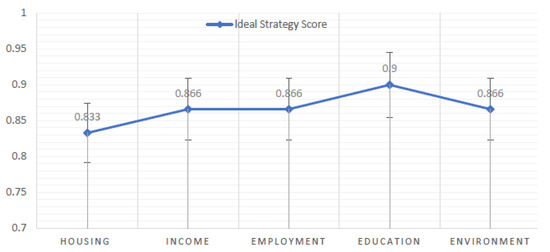
Figure 2.
Ideal strategy.
Step 3: Use the aggregation operator defined in Theorem 1 to aggregate all the individual normalized spherical fuzzy decision matrices. The aggregated spherical fuzzy decision matrix is shown in Table 8:

Table 8.
Collective spherical fuzzy decision information matrix R.
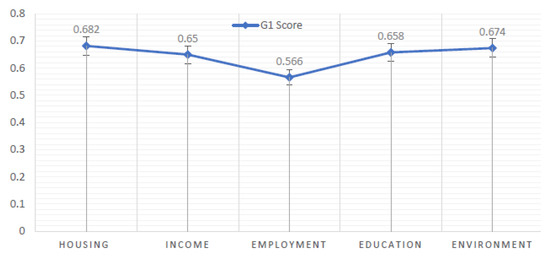
Figure 3.
representation.
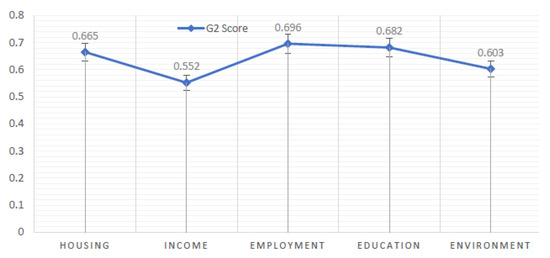
Figure 4.
representation.
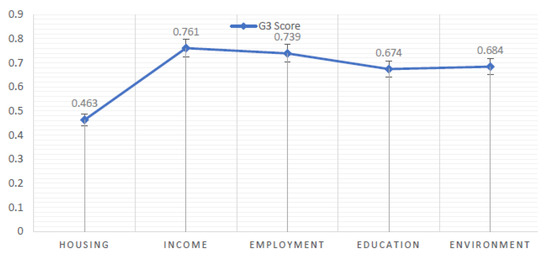
Figure 5.
representation.
Step 4: Use the family of the operator to aggregate the spherical individual fuzzy decision matrix with the constructed ideal strategy. Here, the weight information is unknown. Therefore, firstly, we utilize the above defined techniques (1)–(3) to calculate the associated weights. The weights using the technique (1) are calculated as Furthermore, the given weighted weights are Use the associated and weighted weights to find the weighted averaging weights as:
Now, use the SFDWA operator to find the distances form the ideal Strategy shown in Table 9 and Table 10.

Table 9.
Aggregated distance information matrix.

Table 10.
Aggregated distance information matrix.
The graphical representation of the distance from each alternative using the normalized Hamming distance is shown in Figure 6.
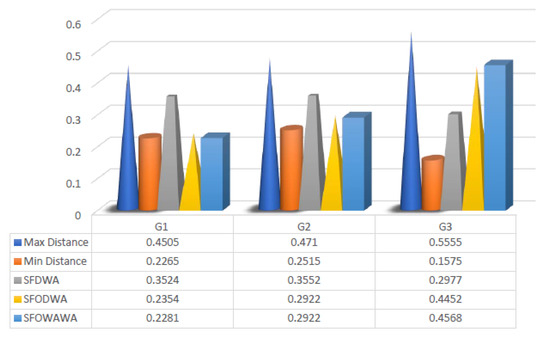
Figure 6.
Distance of alternative using the normalized Hamming distance.
The graphical representation of the distance from each alternative using the normalized Euclidean distance is shown in Figure 7.
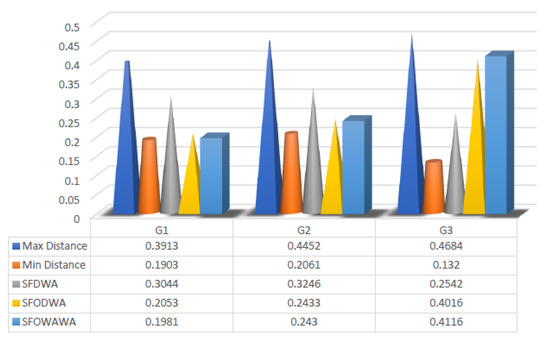
Figure 7.
Distance of alternative using Normalized Euclidean Distance.

Table 11.
Final ranking.

Table 12.
Final ranking.
The graphical representation of the final ranking for each alternative using the normalized Hamming distance is shown in Figure 8.
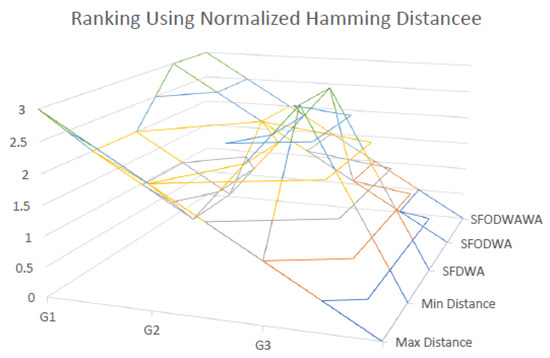
Figure 8.
Final ranking for each alternative using the normalized Hamming distance.
The graphical representation of the final ranking for each alternative using the normalized Euclidean distance is shown in Figure 9.
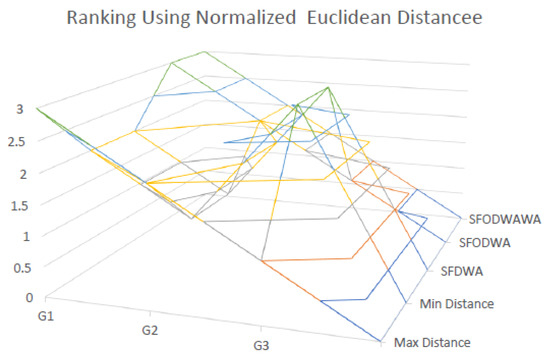
Figure 9.
Final Ranking for each alternative using the normalized Euclidean distance.
Then, the ranking order of the alternative is and the best outcome is
6. Conclusions
The distance-weighted averaging operators are generally suitable for dealing with the MCGDM problems in which the information takes the form of numerical values, yet they will fail when dealing with MCGDM problems in which the information takes the form of spherical fuzzy information. In this paper, we establish the multiple objective optimization models based on the distance-weighted averaging operators. Since in decision making, distance aggregation operators play a vital role, therefore, in this paper, we developed distance aggregation operators, namely spherical fuzzy distance-weighted averaging (SFDWA), spherical fuzzy distance order-weighted averaging (SFDOWA), and spherical fuzzy weighted averaging order-weighted averaging (SFDOWAWA) operators with information about attribute weights incompletely known. We also saw that how the SFDWA operator provided a parametric family of aggregation operator and distance measures. To determine the attribute, we proposed the optimization models based on these distance aggregated operators. Finally, we designed an algorithm to solve MCGDM problems based on these distance-weighted averaging operators under spherical fuzzy information with unknown information about the weights. The child development influence environmental factors problem was given as a practical application to demonstrate the usage and applicability of the proposed ranking approach. We saw graphically how aggregated information of an attribute is similar to the ideal strategy, the calculated distance of each attribute to the ideal strategy, and the ranking of the attributes.
Author Contributions
Conceptualization, S.A. (Shahzaib Ashraf) and S.A. (Saleem Abdullah); methodology, S.A. (Shahzaib Ashraf); software, S.A. (Shahzaib Ashraf); validation, S.A. (Shahzaib Ashraf), S.A. (Saleem Abdullah) and L.A.; investigation, S.A. (Shahzaib Ashraf), S.A. (Saleem Abdullah); resources, L.A.; data curation, S.A. (Saleem Abdullah) and L.A.; writing, original draft preparation, S.A. (Shahzaib Ashraf); writing, review and editing, S.A. (Shahzaib Ashraf); visualization, S.A. (Saleem Abdullah); supervision, S.A. (Saleem Abdullah); funding acquisition, L.A.
Funding
This study was funded by Fundamental Research Grant Scheme (FGRS), No. 59522, Ministry of Education Malaysia, and University Malaysia Terengganu.
Acknowledgments
The authors would like to thank the Editor in Chief, the Associate Editor, and the anonymous referees for detailed and valuable comments, which helped to improve this manuscript.
Conflicts of Interest
The authors declare no conflict of interest.
References
- Zadeh, L.A. Fuzzy sets. Inf. Control 1965, 8, 338–353. [Google Scholar]
- Atanassov, K. Intuitionistic fuzzy sets. Fuzzy Sets Syst. 1986, 20, 87–96. [Google Scholar]
- Yager, R.R. On ordered weighted averaging aggregation operators in multi criteria decision making. IEEE Trans. Syst. Man Cybern. 1988, 18, 183–190. [Google Scholar]
- Xu, Z.; Yager, R.R. Some geometric aggregation operators based on intuitionistic fuzzy sets. Int. J. Gen. Syst. 2006, 35, 417–433. [Google Scholar]
- Xu, Z. Intuitionistic fuzzy aggregation operators. IEEE Trans. Fuzzy Syst. 2007, 15, 1179–1187. [Google Scholar]
- Wang, W.; Liu, X. Intuitionistic fuzzy geometric aggregation operators based on Einstein operations. International Journal of Intell. Syst. 2011, 26, 1049–1075. [Google Scholar]
- Wang, W.; Liu, X. Intuitionistic fuzzy information aggregation using Einstein operations. IEEE Trans. Fuzzy Syst. 2012, 20, 923–938. [Google Scholar]
- Yager, R.R. Pythagorean fuzzy subsets. In Proceedings of the 2013 Joint IFSA World Congress and NAFIPS Annual Meeting (IFSA/NAFIPS), Edmonton, AB, Canada, 24–28 June 2013; pp. 57–61. [Google Scholar]
- Khan, A.A.; Ashraf, S.; Abdullah, S.; Qiyas, M.; Luo, J.; Khan, S.U. Pythagorean fuzzy Dombi aggregation operators and their application in decision support system. Symmetry 2019, 11, 383. [Google Scholar]
- Zhang, X.; Xu, Z. Extension of TOPSIS to multiple criteria decision making with Pythagorean fuzzy sets. Int. J. Intell. Syst. 2014, 29, 1061–1078. [Google Scholar]
- Yager, R.R.; Abbasov, A.M. Pythagorean membership grades, complex numbers, and decision making. Int. J. Intell. Syst. 2013, 28, 436–452. [Google Scholar]
- Yager, R.R. Weighted triangular norms using generating functions. Int. J. Intell. Syst. 2004, 19, 217–231. [Google Scholar]
- Rahman, K.; Abdullah, S.; Ahmed, R.; Ullah, M. Pythagorean fuzzy Einstein weighted geometric aggregation operator and their application to multiple attribute group decision making. J. Intell. Fuzzy Syst. 2017, 33, 635–647. [Google Scholar]
- Garg, H. New logarithmic operational laws and their aggregation operators for Pythagorean fuzzy set and their applications. Int. J. Intell. Syst. 2018, 34, 82–106. [Google Scholar] [CrossRef]
- Cuong, B.C. Picture fuzzy sets. J. Comput. Sci. Cybern. 2014, 30, 409–420. [Google Scholar]
- Wei, G. Picture fuzzy cross-entropy for multiple attribute decision making problems. J. Bus. Econ. Manag. 2016, 17, 491–502. [Google Scholar]
- Wei, G. Picture fuzzy aggregation operators and their application to multiple attribute decision making. J. Intell. Fuzzy Syst. 2017, 33, 713–724. [Google Scholar]
- Wei, G. Picture 2-tuple linguistic Bonferroni mean operators and their application to multiple attribute decision making. Int. J. Fuzzy Syst. 2017, 19, 997–1010. [Google Scholar]
- Ashraf, S.; Mahmood, T.; Abdullah, S.; Khan, Q. Different approaches to multi-criteria group decision making problems for picture fuzzy environment. Bull. Braz. Math. Soc. New Ser. 2018, 50, 373–397. [Google Scholar]
- Ashraf, S.; Mehmood, T.; Abdullah, S.; Khan, Q. Picture Fuzzy Linguistic Sets and Their Applications for Multi-Attribute Group. Nucleus 2018, 55, 66–73. [Google Scholar]
- Khan, M.J.; Kumam, P.; Ashraf, S.; Kumam, W. Generalized Picture Fuzzy Soft Sets and Their Application in Decision Support Systems. Symmetry 2019, 11, 415. [Google Scholar]
- Zeng, S.; Ashraf, S.; Arif, M.; Abdullah, S. Application of exponential jensen picture fuzzy divergence measure in multi-criteria group decision making. Mathematics 2019, 7, 191. [Google Scholar]
- Khan, S.; Abdullah, S.; Ashraf, S. Picture fuzzy aggregation information based on Einstein operations and their application in decision making. Math. Sci. 2019, 1–17. [Google Scholar] [CrossRef]
- Qiyas, M.; Abdullah, S.; Ashraf, S. Solution of multi-criteria group decision making problem based on picture linguistic informations. Int. J. Algebra Stat. 2019, 8, 1–11. [Google Scholar]
- Ashraf, S.; Abdullah, S.; Qadir, A. Novel concept of cubic picture fuzzy sets. J. New Theory 2018, 24, 59–72. [Google Scholar]
- Ashraf, S.; Abdullah, S. Spherical aggregation operators and their application in multiattribute group decision-making. Int. J. Intell. Syst. 2019, 34, 493–523. [Google Scholar]
- Ashraf, S.; Abdullah, S.; Mahmood, T.; Ghani, F.; Mahmood, T. Spherical fuzzy sets and their applications in multi-attribute decision making problems. J. Intell. Fuzzy Syst. 2019, 36, 2829–2844. [Google Scholar]
- Ashraf, S.; Abdullah, S.; Mahmood, T. GRA method based on spherical linguistic fuzzy Choquet integral environment and its application in multi-attribute decision-making problems. Math. Sci. 2018, 12, 263–275. [Google Scholar]
- Ashraf, S.; Abdullah, S.; Aslam, M.; Qiyas, M.; Kutbi, M.A. Spherical fuzzy sets and its representation of spherical fuzzy t-norms and t-conorms. J. Intell. Fuzzy Syst. 2019, 36, 6089–6102. [Google Scholar]
- Rafiq, M.; Ashraf, S.; Abdullah, S.; Mahmood, T.; Muhammad, S. The cosine similarity measures of spherical fuzzy sets and their applications in decision making. J. Intell. Fuzzy Syst. 2019, 36, 6059–6073. [Google Scholar]
- Zeng, S.; Hussain, A.; Mahmood, T.; Irfan Ali, M.; Ashraf, S.; Munir, M. Covering-Based Spherical Fuzzy Rough Set Model Hybrid with TOPSIS for Multi-Attribute Decision-Making. Symmetry 2019, 11, 547. [Google Scholar]
- Ashraf, S.; Abdullah, S.; Mahmood, T. Spherical fuzzy Dombi aggregation operators and their application in group decision making problems. J. Ambient Intell. Humaniz. Comput. 2019, 1–19. [Google Scholar] [CrossRef]
- Jin, Y.; Ashraf, S.; Abdullah, S. Spherical Fuzzy Logarithmic Aggregation Operators Based on Entropy and Their Application in Decision Support Systems. Entropy 2019, 21, 628. [Google Scholar] [CrossRef]
- Jin, H.; Ashraf, S.; Abdullah, S.; Qiyas, M.; Bano, M.; Zeng, S. Linguistic Spherical Fuzzy Aggregation Operators and Their Applications in Multi-Attribute Decision Making Problems. Mathematics 2019, 7, 413. [Google Scholar]
- Merigó, J.M.; Gil-Lafuente, A.M. New decision-making techniques and their application in the selection of financial products. Inf. Sci. 2010, 180, 2085–2094. [Google Scholar]
© 2019 by the authors. Licensee MDPI, Basel, Switzerland. This article is an open access article distributed under the terms and conditions of the Creative Commons Attribution (CC BY) license (http://creativecommons.org/licenses/by/4.0/).